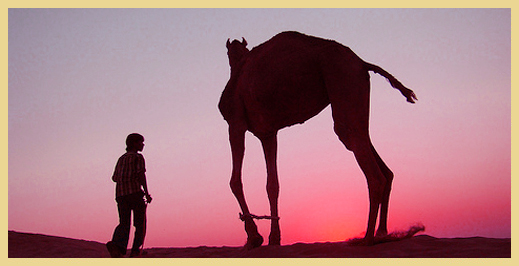| |
|
|
|
|
Jaisalmer Fort:
The Jaisalmer Fort built in 12th century, has been
regarded as one of the most magnificent and invincible
forts in Rajasthan. It was built in 1156 A.D. by the Bhati
Rajput ruler Rawal Jaisal, from where it derives it name.
The fort stands proudly amidst the golden stretches of the
great Thar Desert . Jaisalmer Fort in Jaisalmer has a
typical gadget hoisted on crest of its walls. It was used
to predict the weather. Each year, in April a placard
would be positioned in its center. The course in which it
wafted decided the weather conditions for the entire year.
If you are a student of cross-cultural merging, the subtle
fusion of Rajput and Islamic architectural styles, visible
in this fort, will catch your fancy. The fort looks more
stunning at the night. |
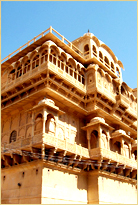 |
|
Gadsisar Lake:
Gadsisar Lake is one of the major tourist attractions of
Jaisalmer. It is a scenic rain water lake with numerous
beautiful shrines around and a spectacular avian variety.
Lake was built by Maharawal Garsi Singh in 1367 A.D. It
was the sole source of drinking water till as recently as
1965. It is the host of many migratory and rare birds. Its
picturesque sandstone banks look stunning. The boat ride
in the lake is a pleasant experience. The lake is now a
picnic spot. |
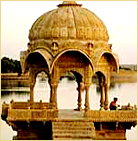 |
|
The Jain Temple:
The Jain Temples Jaisalmer dates back to the 12th century
construction resembling the style of the exquisitely
carved Dilwara temples. Devoted to the Jain Tirthankaras,
they are examples of great skill and expertise in
intricate stonework. The Jain temples in the Jaisalmer
Fort are dedicated to Rikhabdevji and Shambhavdev Ji, the
famous Jain hermits known as 'Tirthankars'. There is an
emerald statue of Lord Mahavira within the Paraswanath
Temple sanctum that exudes an aura of peace and tolerance.
These Jain temples are open to public from the early hours
of morning till 12 noon. You must tour the Gyan Bhandar
library attached to one of these Jain temples. The Gyan
Bhandar happens to be a rich storehouse of historical
texts related to the history of these wonderfully carved
Jain temples. Like all other structures in Jaisalmer,
these temples are carved of yellow sandstones. |
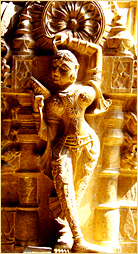 |
|
Tazia Tower:
Magnificent Tazia Tower is located within the
Jaisalmer Fort premises. Constructed in the style of a
pagoda, the five-storied Tazia Tower was carefully crafted
by Muslim artisans. Tazia is actually the replica of
Mausoleum of various Imams. They are made of wood,
thermocol and colored papers. The Tazia Tower is credited
with imposing balconies in each of its floor and they are
pretty attractive with its distinct design and
architectural style. |
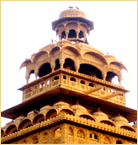 |
|
Nathmalji ki Haveli:
Made by two brothers Hathi and Lalu, this 19th century
residence of the Nathmals is a must see among Jaisalmer
havelis. The two architects worked independently on two
different wings of this exquisite haveli. Interestingly,
while one concentrated on the right, the other
concentrated on the left and the result is a symphony
epitomising the side by side symmetry during construction.
The entrance to Nathmal’s haveli is zealously guarded by
stone elephants; and the entire façade is embellished with
a slew of detailing – horses, elephants, soldiers, flowers
and birds. |
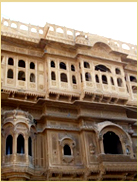 |
|
Patwon ki Haveli:
Built about 300 years ago, the Patwon ki Haveli in
Jaisalmer one of the largest and the most splendid haveli
of Rajasthan. It is five storeys high and is extensively
carved. The first was constructed circa 1805 by a merchant
called Guman Chand Patwa and is the biggest and the most
ostentatious. Patwa was a man of considerable means, and
for his five sons he built the elaborate five-storeyed
complex which reportedly took 50 years to finish. Built by
the well-renowned dealers in brocade, gold and silver
embroidery of their time from Afghanistan to China. |
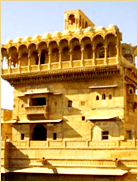 |
|
Salim Singh ki Haveli:
On your heritage haveli tours in Rajasthan, visit the most
impressive mansion and haveli in Jaisalmer, Salim Singh ki
Haveli, built by the Jain diwan Salim Singh Mohta. This
stately Jaisalmer haveli with its stunning blue cupola
roof is resplendent with exquisite stone carvings, screen
windows and exotic murals. The mansion is just below the
hill and it is said that once it had two additional wooden
storeys in an attempt to make it as high as the maharaja's
palace, but the maharaja had the upper storey torn down.
|
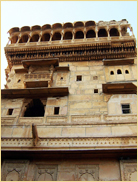 |
|
Folklore Museum:
Situated on the banks of the Garsisar lake the museum is a
gold mine of information not just about Jaisalmer, but the
rich cultural heritage of western Rajasthan. Established
in 1984 by N K Sharma, the Folklore Museum is divided into
six sections making it more organized. The six sections
include a coterie of paintings, costumes, jewelery,
photographs, camel and horse ornaments and fossils. You
can visit this Rajasthan museum on any day of the week
from 9 a.m.-12 p.m. and 3 p.m.-6 p.m. |
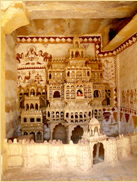 |
|
|
|
